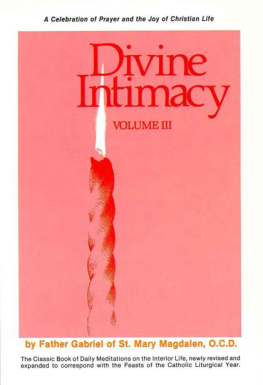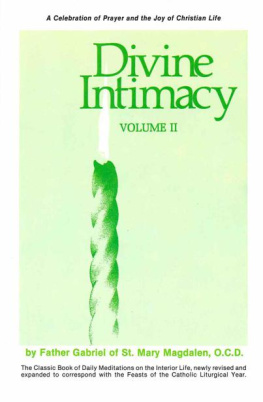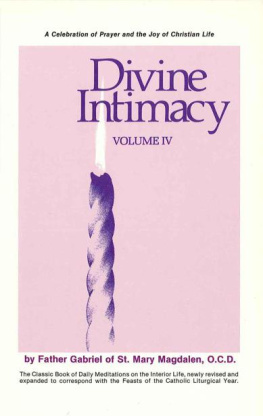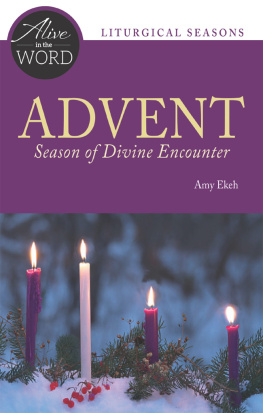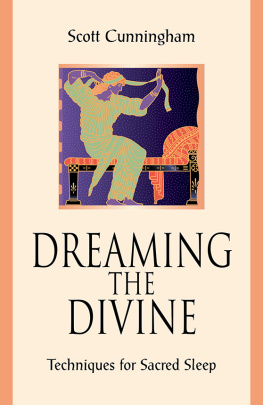FATHER GABRIEL OF ST. MARY MAGDALEN, O.C.D.
DIVINE INTIMACY
Volume I
First Sunday of Advent through
the Eighth Week of Ordinary Time
IGNATIUS PRESS SAN FRANCISCO
This enlarged and revised edition was
previously published by Dimension Books, Inc.
Translated from the Sixteenth Italian Edition
Carmelite Monastery of Pittsford, N.Y.
With ecclesiastical approval
Carmelite Monastery, Pittsford, N.Y. 14534
All rights reserved
Reprinted with permission of Dimension Books, 1987
ISBN 978-0-89870-142-5
Library of Congress catalogue number 86-83132
Printed in the United States of America
TABLE OF CONTENTS
ADVENT SEASON
Meditation
year A
year B
year C
year A
year B
year C
year A
year B
year C
year A
year B
year C
CHRISTMAS SEASON
ORDINARY TIME
year A
year B
year C
year A
year B
year C
year A
year B
year C
year A
year B
year C
year A
year B
year C
year A
year B
year C
year A
year B
year C
FOREWORD
Divine Intimacy is a well known name throughout the world today, which would need no introduction now were it not for the revision of it that has been made in the light of Vatican II.
In actual fact, this present book is not new, and yet at the same time it is new.
Its author, Fr. Gabriel of St. Mary Magdalen, O.C.D. (1893-1953) was a teacher who excelled in the ways of God, joining an enviable experience with souls to a vast and profound knowledge of spiritual theology. He had had such a book under consideration for a long time, when, after weighing favorable and contrary opinions, he finally decided to sketch out a plan, convinced that through this projected work he would be able to reach a greater number of the faithful than through the treatise on ascetical-mystical theology upon which he had already been working for many years, which in its turn had been insistently asked for by many. What carried most weight for him was that it seemed, of the two, that Divine Intimacy would do more good by guiding innumerable souls to that loving colloquy with God, that dialogue in spirit and in truth, which, according to St. Teresa of Avila, is the gate through which all good things enter; it would be for the sanctification of the members of the Mystical Body of Christ, who are called to the spiritual banquet through prayer, in order to draw from it the theological charity which would radiate out from them to their brothers.
Once convinced of this, he sought to find time for the new enterprise in spite of every minute being consumed by the duties in which he was already engaged: teaching, editing the Rivista di vita spirituale, collaborating professionally in various publications and dictionaries, preaching spiritual exercises and giving retreats, in addition to his priestly ministry. After he had studied the project and drawn up a carefully detailed plan, he sought the collaboration of the Carmel of S. Giuseppe in Rome which was especially dear to him. By the beginning of November, 1952 he was able to offer the public the first modest volume. Its simple, unpretentious appearance would scarcely lead one to imagine the burning outburst of grace that it would promote as one magnificent edition after another appeared, first in Italian, soon followed by versions in French, Spanish, German, English, Flemish, Polish, Portuguese, Japanese and Croatian. The author himself, though endowed with a rich vein of natural and supernatural optimism, would never have dreamed of the extraordinary success that Divine Intimacy was destined to have.
Six modest volumes followed one another regularly despite the death of Fr. Gabriel, March 15, 1953. It seemed at first that this would put a stop to the work, but the valuable assistance he had sought from S. Giuseppe Carmel proved providential, and the work continued unabated. The numerous writings of Fr. Gabriel, preserved in the Teresian Carmel on the Via Ancillotto (now moved to Via della Nocetta) were an abundant source of material for planning the entire work, which was soon completed, following the authors guidelines and thought.
* * *
He had desired a gradual and meditative exposition of all the great truths of the spiritual life, one that would be grafted upon and incorporated into the liturgical year and its fundamental themes, so that the faithful might be united to the mystery of Christ and the Church. For this reason topics of spiritual theology were to be proposed and presented in the light of the various liturgical seasons, so that the truths which the liturgy set forth would stand out clearly through prayer. Fr. Gabriel had meditated long upon the Mediator of Pius XII, and was enthusiastic about it. For him the liturgy was not a collection of rubrics, but an encounter with God in the Church and with the Church, and he held that, as much as possible, personal prayer should be grafted onto the public prayer of the Mystical Body, by taking its tone and finding its starting point in the great stages of salvation history as presented by the liturgical year. The finished work corresponded to the ideal he had dreamed of, and many book-reviews, especially in German speaking countries, emphasized the liturgical value of Divine Intimacy, while, at the same time, pointed out that its liturgical spirit was directed toward promoting a personal contact with God. In its turn, the sure spiritual doctrine it contains inspires us to understand and live the treasures of the liturgy in a new manner.
With the flourishing of studies and fuller appreciation of liturgical life, all that Fr. Gabriel had planned could not but seem providential. Testimony to this, pouring in from all sides and from the most diverse parts of the world, bore witness to the authors wisdom, and manifested the deep gratitude of the many who considered themselves indebted to him for the richness of the spiritual teaching to be found in his work.
* * *
Fr. Gabriel had been occupied for many years with theology, and during his last ten years, especially with spiritual theology. For the most part he followed the teaching of St. Teresa of Jesus and St. John of the Cross, whose doctrine he made come alive through the clarity and directness of his explanations, which were made still more effective by his great experience in dealing with souls. For this reason, even when texts or expressions are not directly quoted, one soon discovers a constant echo of the words of these Doctors of Carmel, which had already long been the substance of his doctrine. This can be observed all through Divine Intimacy, where the teaching of St. Teresa and of St. John of the Cross, together with that of other masters of the Teresian Carmel, abounds, not only in numerous explicit citations from their writings, but also in the very flow of expression. This accounts for the effortless ease with which the liturgical text, enriched by facts of spiritual theology, is offered throughout the book, creating an harmonious and beneficial continuity between the liturgy and piety.
* * *
This work has been revised and retouched many times, always keeping the spirit and way of thinking of the author in the forefront; he was ever a faithful son of the Church whom he loved with a true passion. For him feeling with the Church was the norm of life, and it is well known how and to what an extent he nurtured this feeling by an assiduous and careful reading of the documents which were promulgated by the hierarchy and especially by the Holy Father. How often, day after day, he could be seen in the choir in prayer, deep in meditation upon the great encyclicals or discourses of Pius XII! He would read carefully, then close the booklet and remain in peaceful, prolonged meditation. From the very outset, the pages of Divine Intimacy clearly bore the imprint of this pontifical teaching which he held to be a means of communion with the Church and an irreplaceable instrument of a sure theological updating.
Next page

